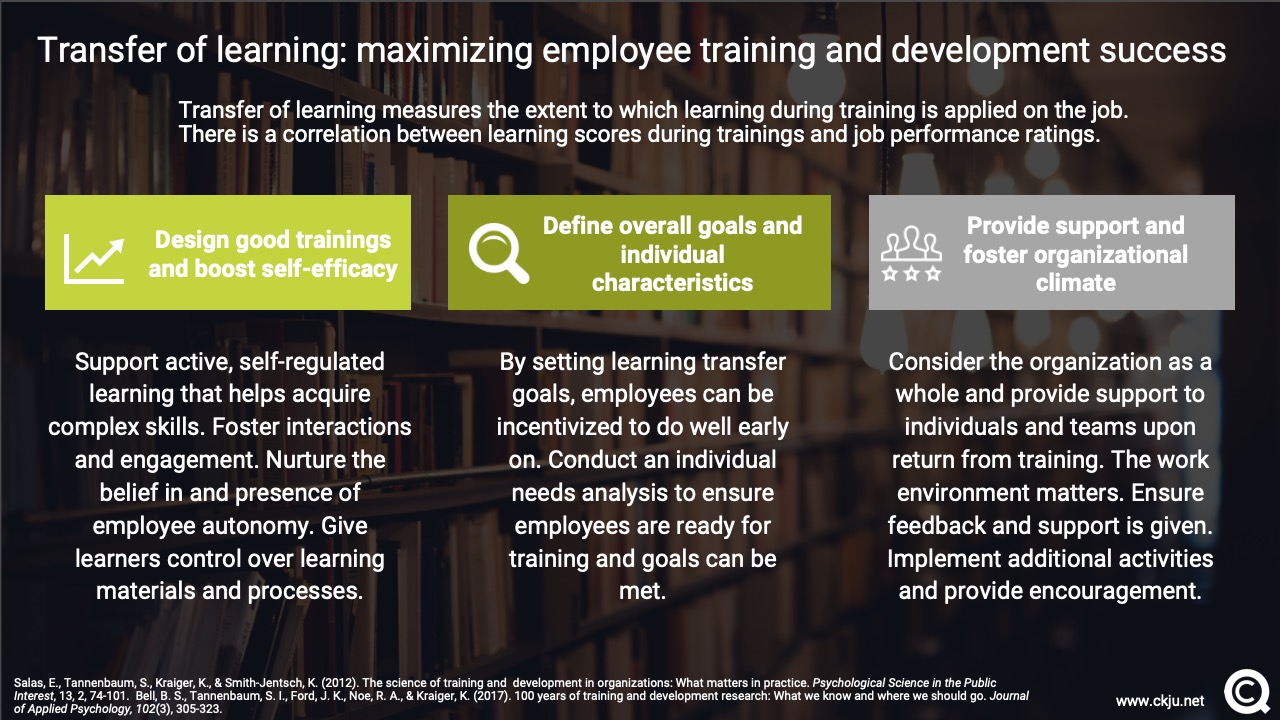- Blog
- Transfer of learning
Contents
- What is transfer of learning?
- Factors that predict whether transfer of training takes place.
- Boost self-efficacy.
- Define learning transfer goals.
- Provide management support.
- Conduct team debriefs that act as a post-training intervention.
- Ensure that organizational climate fosters transfer of learning.
- Identify trainee characteristics that predict the transfer of learning.
- Design trainings that support active, self-regulated learning.
- What do HRD professionals recommend for the transfer of training?
- Focus on pre-training, during training and post-training interventions to maximize the transfer of training.
- References and further reading
A recent survey found that 75% of 1500 senior managers at 50 organizations were not satisfied with their organizations’ transfer of training outcomes (Beer, Finnstrom & Schrader, 2016). Moreover, as little as 10 percent to 40 percent of the knowledge or skills taught in training programs are effectively transferred to the workplace (Burke & Hutchins, 2007). This blog describes learning transfer and those factors that facilitate successful transfer of knowledge and skills for effective individual performance.
What is transfer of learning?
Transfer of learning is a crucial indicator of training effectiveness because it measures the extent to which learning during training is applied on the job (Salas et al., 2012). Transfer of training is shown when there is a statistically significant correlation between learning scores during training and job performance ratings. However, successful learning that occurs during a training program does not automatically translate into successful performance in the work environment.
Factors that predict whether transfer of training takes place.
It is important to understand which factors predict successful learning transfer. In a meta-analytic review of the training motivation, Colquitt and colleagues (2000) found that the following three factors increase the transfer of training:
- trainee characteristics (locus of control),
- pre-training self-efficacy and
- individual beliefs concerning training values predicted training transfer.
We have a look at these factors and some examples on how they can be used to the transfer of learning.
Boost self-efficacy.
One of the best ways in which Human Resource Development (HRD) professionals can increase learning transfer is through self-efficacy interventions. Self-efficacy refers to one’s belief in the ability to carry out a series of behaviors in a situation. Current research on training and development recognizes that the learner is an active learner in the training process and a focus on self-efficacy demonstrates that the learner has control over the material that they process and absorb (Baldwin et al., 2017).
Define learning transfer goals.
In fact, when trainees do not feel pressurized from management to transfer what they learned, they are more motivated to transfer their knowledge (Huang, Blume, Ford & Baldwin, 2015). Self-efficacy is a key factor in self-regulated learning (Sitzmann & Ely, 2011) and when trainees have confidence in setting transfer goals, this can encourage trainees to attempt new skills early on and can increase application over time (Huang et al., 2015).
Management skills newsletter
Join our monthly newsletter to receive management tips, tricks and insights directly into your inbox!
Provide management support.
A common thread in research on learning transfer is that the application of trained skills to the job are influenced by the work environment (e.g., Bell et al,. 2017). What happens before and after training can influence the transfer of learning, so it is important to take a systems perspective that goes beyond trainee characteristics and considers organizational content.
One important organizational factor is through managers providing support to individual and team members when they return from training. Research shows that supervisor and peer support determine the extent to which knowledge and skills are applied on the job (Bell et al., 2017). Research also shows that management support is also crucial for team learning and the transfer of training.
Conduct team debriefs that act as a post-training intervention.
After team members have completed training, team debriefs act as a post-training intervention in which the leader reviews examples of successful performance with respect to tasks and team work (Bell et al., 2017). Moreover, managerial support can also influence whether employees choose to participate in non-mandatory developmental activities (Bell et al., 2017). Team leaders can shape the degree of learning transfer through informal reinforcement of transfer activities (Smith-Jentsch et al., 2001).
Ensure that organizational climate fosters transfer of learning.
Research has also shown that what happens before and after training predicts transfer. Saks and Belcourt (2006) examined the effect of activities before training such as supervisor involvement, during training (training feedback and rewards) and after training (organization and supervisor support) on learning transfer. They found that pre-training and post-training activities were more strongly related to the transfer of learning than were activities during training.
Organizational climate influences participation in developmental activities and their effectiveness because the climate either increases or decreases employees’ motivation to learn and to transfer what they learned.
Identify trainee characteristics that predict the transfer of learning.
Research has shown that trainee individual differences such as IQ and self-efficacy, influence how much employees learn and transfer to their jobs (Bell et al., 2017). Prior to training, it is important to conduct a needs analysis to ensure that trainees are ready for training because this can predict training transfer. In a meta-analysis, Colquitt and his colleagues found that trainee motivation explains training transfer beyond the effects of trainee cognitive ability (Colquitt et al., 2000).
Design trainings that support active, self-regulated learning.
Despite the popularity of the lecture as a training method, passive forms of learning can be deleterious to training transfer. It is important that training is designed to encouraged and support active, self-regulated learning that facilitates the acquisition of complex skills (Bell et al., 2017). It is important that trainers actively engage the learner through interactions that engage and increase motivation to transfer such as effective trainer delivery (Towler & Dipboye, 2001).
What do HRD professionals recommend for the transfer of training?
Burke and Hutchins (2008 conducted a survey of American Society of Training and Development (ASTD) professionals to determine best practices for supporting the transfer of training. They found that interventions for bolstering training transfer were best carried out in the work context design and delivery phase, take place after or during training, and involve trainers and supervisors. Some of the best practices include supervisory support activities, coaching, opportunities to perform, interactive training activities and job-relevant training.
Focus on pre-training, during training and post-training interventions to maximize the transfer of training.
In closing, it is important for HRD professionals to consider those factors that predict the transfer of training. In adopting a systems approach, HRD professionals can focus on pre-training, during training and post-training interventions to ensure that trainees transfer the knowledge and skills they have acquired during training. Positive transfer occurs when training facilitates acquiring a new skill or finding solutions to a new problem. If training is successful, then the trainee will perform better in transferring knowledge and skills.
References and further reading
Baldwin, T. T., Kevin Ford, J., & Blume, B. D. (2017). The State of Transfer of Training Research: Moving Toward More Co& nsumer-Centric Inquiry. Human Resource Development Quarterly, 28(1), 17–28.
Bell, B. S., Tannenbaum, S. I., Ford, J. K., Noe, R. A., & Kraiger, K. (2017). 100 years of training and development research: What we know and where we should go. Journal of Applied Psychology, 102(3), 305-323.
Beer, M., Finnstrom, M., & Schrader, D. (2016, October). Why leadership training fails—and what to do about it. Harvard Business Review, 94, 50–57.
Burke, L. A., & Hutchins, H. M. (2008). A study of best practices in training transfer and proposed model for transfer. Human Resource Development Quarterly, 19/2, pp. 107- 128
Colquitt, J., LePine, J., Noe, R. (2000). Toward an integrative theory of training motivation: a meta analytic path analysis of 20 years of research. Journal of Applied Psychology, 85, pp. 678–707.
Huang, J.L., Blume, B.D., Ford, J.K., Baldwin, T.T. (2015). A tale of two transfers? Disentangling maximum and typical transfer and their respective predictors. Journal of Business and Psychology, 30, 709–732. doi: 10.1007/s10869-014-9394-1
Saks, A., & Belcourt, M. (2006). An investigation of training activities and transfer of training in organizations. Human Resource Management, 45, pp. 629–648.
Salas, E., Tannenbaum, S., Kraiger, K., & Smith-Jentsch, K. (2012). The science of training and development in organizations: What matters in practice. Psychological Science in the Public Interest, 13, 2, 74-101.
Sitzmann, T., & Ely,( K. (2011). A meta-analysis of self-regulated learning in work-related training and educational attainment: What we know and where we need to go. Psychological Bulletin, 137, 421–442.
Smith-Jentsch, K., Salas, E., & Brannick, M. (2001). To transfer or not to transfer? Investigating the combined effects of trainee characteristics, team leader support and team climate. Journal of Applied Psychology, 86, pp. 279–292.
Towler, A.J, & Dipboye, R.L. (2001) Effects of trainer expressiveness, organization, and trainee goal orientation on training outcomes. The Journal of Applied Psychology. 86: 664-73.
Top Rated
About the Author

Comments
Most Read Articles
Blog Categories
RELATED SERVICES










Add comment